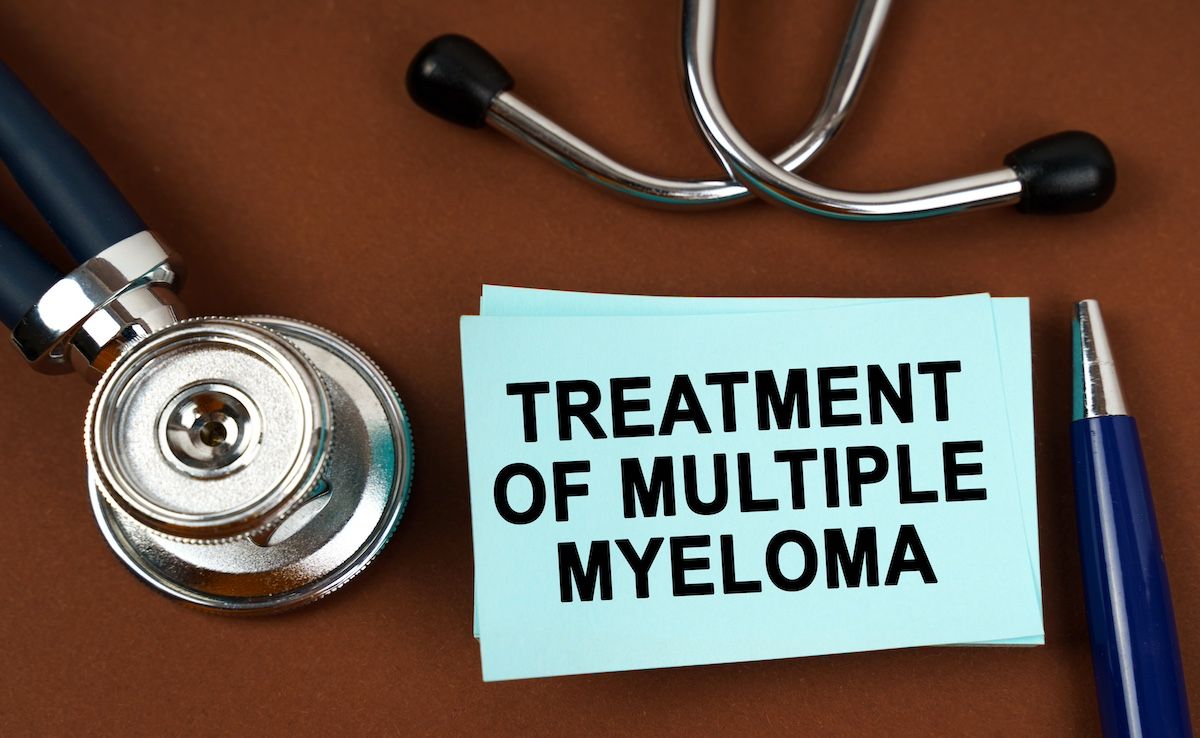News
Article
OS Better With Belantamab Mafodotin Triplet vs Daratumumab in R/R MM
Key Takeaways
- The DREAMM-7 trial showed belantamab mafodotin combination significantly improved overall survival in relapsed/refractory multiple myeloma compared to daratumumab-based therapy.
- The investigational arm demonstrated superior progression-free survival and overall response rates, despite higher adverse event rates.
The key secondary end point of overall survival (OS) was met in the DREAMM-7 trial of belantamab mafodotin (Blenrep; GSK) for the treatment of patients with relapsed/refractory multiple myeloma (R/R MM).
This article was first published by Targeted Oncology™.
The combination of belantamab mafodotin-blmf (Blenrep; GSK) with bortezomib (Velcade; Takeda) and dexamethasone elicited a statistically significant and clinically meaningful reduction in the risk of death vs daratumumab (Darzalex; Janssen) plus bortezomib and dexamethasone for use against relapsed/refractory (R/R) multiple myeloma, according to findings from the phase 3 DREAMM-7 trial (NCT04246047).1
With this result, the key secondary end point of overall survival (OS) in DREAMM-7 has been met. Full results from the interim analysis of the DREAMM-7 trial are expected to be presented during the 2024 American Society of Hematology (ASH) Annual Meeting in December.
“The OS results from the DREAMM-7 trial underscore the potential for this belantamab mafodotin combination to extend the lives of patients with relapsed/refractory multiple myeloma,” said Hesham Abdullah, MD, MSc, senior vice president, global head of oncology, Research and Revelopment, GSK, in a statement.1 “This is a statistically significant and clinically meaningful advancement for patients and potentially transformative for treatment. We look forward to sharing these data with health authorities and presenting the full results at next month’s ASH Annual Meeting.”
In the multicenter, open-label, global DREAMM-7 trial, investigators sought to assess belantamab mafodotin combined with bortezomib and dexamethasone compared with daratumumab plus bortezomib and dexamethasone in patients with R/R multiple myeloma after at least 1 previous line of therapy.2
Patients included were required to have disease progression during or after their most recent treatment, adequate organ function, and an ECOG performance status of 0 to 2. All prior treatment-related adverse events (AEs) had to be resolved to grade 1 or lower, with the exception of alopecia.3
A total of 494 patients were randomized 1:1 to the belantamab mafodotin or daratumumab arms. Patients in the belantamab mafodotin arm received 2.5 mg/kg of the agent administered intravenously every 3 weeks.
The primary end point of the trial was progression-free survival (PFS), and secondary end points included complete response rate, overall response rate (ORR), clinical benefit rate, duration of response (DOR), time to response, time to progression, OS, PFS on subsequent line of therapy (PFS2), minimal residual disease, and incidence of AEs.3
With these newest data from the phase 3 DREAMM-7 trial, the key secondary end point of overall survival has been met. | Image Credit: © Dzmitry-stock.adobe.com

According to data previously published in The New England Journal of Medicine, at a median follow-up of 28.2 (range, 0.1-40.0) months, patients given belantamab mafodotin (n = 243) in the DREAMM-7 study had a median PFS of 36.6 (95% CI, 28.4-not reached [NR]) months vs 13.4 (95% CI, 11.1-17.5) months in the control arm (n = 251; HR, 0.41; 95% CI, 0.31-0.53; P < .001). At 18 months, the PFS rates in these arms were 69% and 43%, respectively.2
Results from the prior analysis also showed that the median OS was 33.9 (95% CI, 21.9-NR) months in the belantamab mafodotin arm vs 15.2 (95% CI, 12.3-21.1) months in the control arm (HR, 0.57; 95% CI, 0.40-0.80). OS rates at 18 months were 84% vs 73%, respectively.
For ORRs, rates were 83% (95% CI, 77%-87%) vs 71% (95% CI, 65%-77%), respectively, in the experimental vs control arms. The median DOR was 35.6 (95% CI, 30.5-NR) months in the belantamab mafodotin arm vs 17.8 (95% CI, 13.8-23.6) months in the control arm.
Looking at safety, all 242 patients in the investigational arm and 246 in the control arm reported an AE of any grade. Grade 3 or higher AEs occurred in 95% and 78% of patients, respectively. Both groups experienced any-grade blood and lymphatic system disorders (76% vs 64%), infections and infestations (70% vs 67%), and ocular events (79% vs 29%).
AEs leading to discontinuation of any study drug were reported in 5% and 2% of patients in the treatment and control arms, respectively, while serious AEs resulting in death were observed in 10% and 8% of each group.
Ongoing Trials of Belantamab Mafodotin in MM
The DREAMM clinical development program is also exploring the use of belantamab mafodotin in earlier treatment lines, and in combination with novel agents and established therapies. DREAMM-8 (NCT04484623) is assessing the combination of belantamab mafodotin, pomalidomide (Pomalyst; Bristol Myers Squibb), and dexamethasone in patients with R/R multiple myeloma.1
The DREAMM-7 and DREAMM-8 trials have been the basis for advancing regulatory submissions for belantamab mafodotin in R/R multiple myeloma across several regions and countries, including the US, European Union, Japan, United Kingdom, Canada, and Switzerland.
Based on DREAMM-7 findings, China’s National Medical Products Administration has granted breakthrough therapy designation to the combination of belantamab mafodotin, bortezomib, and dexamethasone, along with priority review for regulatory approval.
References
1. Blenrep shows overall survival benefit in head-to-head DREAMM-7 phase III trial for relapsed/refractory multiple myeloma. News release. GSK. November 14, 2024. Accessed November 14, 2024. https://www.gsk.com/en-gb/media/press-releases/blenrep-shows-overall-survival-benefit-in-head-to-head-dreamm-7-phase-iii-trial-for-relapsedrefractory-multiple-myeloma/
2. Hungria V, Robak P, Hus M, et al. Belantamab mafodotin, bortezomib, and dexamethasone for multiple myeloma. N Engl J Med. 2024;391(5):393-407. doi:10.1056/NEJMoa2405090
3. Evaluation of efficacy and safety of belantamab mafodotin, bortezomib and dexamethasone versus daratumumab, bortezomib and dexamethasone in participants with relapsed/refractory multiple myeloma (DREAMM 7). ClinicalTrials.gov. Updated October 24, 2024. Accessed November 14, 2024. https://clinicaltrials.gov/study/NCT04246047




